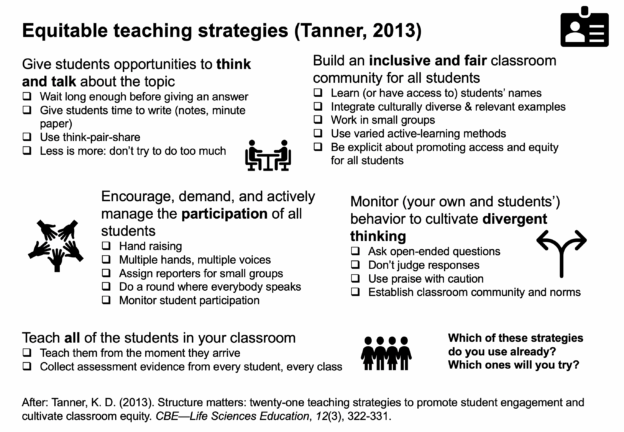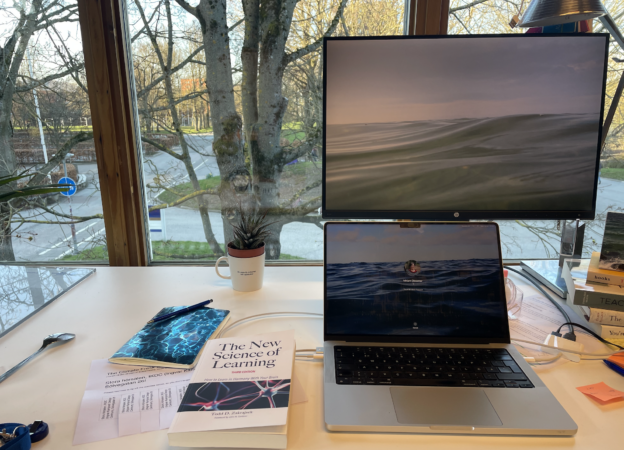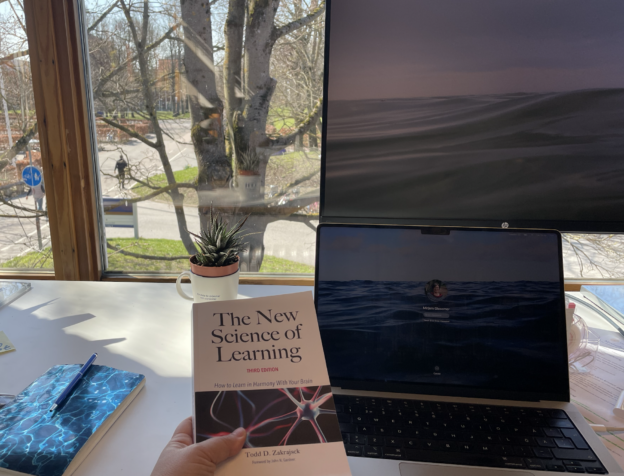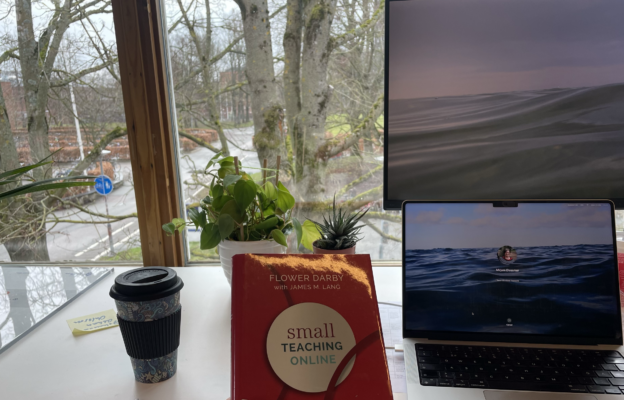I haven’t read a lot of physics education research recently, but this article on how “Physics instructors’ knowledge and use of active learning has increased over the last decade but most still lecture too much” caught my eye. Continue reading


I haven’t read a lot of physics education research recently, but this article on how “Physics instructors’ knowledge and use of active learning has increased over the last decade but most still lecture too much” caught my eye. Continue reading

Teaching for sustainability is about so much more than teaching the content and skills described in the SDGs, or even the cross-cutting sustainability competencies. Today, I talked with teachers who asked what they could do in their courses where the curriculum does not mention anything related to sustainability, and if they should even do anything. Do all courses always need to connect to sustainability? In my opinion, everything is connected to sustainability, and even if you don’t want to explicitly address it in every course and all the time, there are so many things you can do to use your teaching on any content and skills for sustainability.
One article that I find super helpful is “Structure matters: twenty-one teaching strategies to promote student engagement and cultivate classroom equity.” (Tanner, 2013). It is not about sustainability, but it is contributing to it anyway by giving super simple teaching tricks that help teachers to pay attention that all students are invited to participate and to personally connect to the topic. In a nutshell (but go read the original article, since it not only provides a checklist but also explains why each of the strategies is important and why they work): Continue reading

I’m back to browsing the “menu” in my new favorite book, “The New Science of Learning: How to Learn in Harmony with Your Brain” by Zakrajsek (2022). If you haven’t read the first blog post about the book, you might want to read that one first for context.

I found a new YOU HAVE TO READ THIS BOOK!!!-book: “The New Science of Learning: How to Learn in Harmony with Your Brain” by Zakrajsek (2022). It is aimed at students and it might be the most important thing students ever read in school…

This is the third part (part 1 here, part 2 here) of my notes on reading “small teaching online — applying learning science in online classes” by Darby & Lang (2019). Take it with a pinch of salt and go read the original book! These are just my two cents on the points that I find especially relevant for myself.
Part 1, chapter 3 is on “using media and technology tools”, basically saying that not all is gold that glitters, and that we need to be very deliberate in how we use technology. And then there are their tips (clearly written pre-pandemic):

This is the second part (part 1 here) of my notes on reading “small teaching online — applying learning science in online classes” by Darby & Lang (2019). Take it with a pinch of salt and go read the original book! These are just my two cents on the points that I find especially relevant for myself!
Part 1, chapter 2, is on “guiding learning through engagement”, basically how to scaffold learning by designing lots of small signposts and feedback opportunities throughout the duration of a course or project. And this is how they suggest we do it:

I absolutely loved reading the “small teaching” book by Lang (2021), so I was super excited to dig into the related “small teaching online — applying learning science in online classes” by Darby & Lang (2019), and it did not disappoint! I loved it (my only complaint: why didn’t they call it “Tiny Teaching”??? What a missed opportunity!) and — as always — I am summarizing the main points (of the part 1, chapter 1, stay tuned for future posts!) from my perspective below, but it is totally worth reading the actual book! Continue reading
A great teaching method that engages students with literature, and that Cathy Bovill recently introduced me to, are “doughnut rounds”: Students (or workshop participants) are asked to read an article and formulate a certain number of questions, that are then discussed in groups. This leads to people being able to fill in gaps in their understanding (for example due to superficial reading…) and to general engagement with the topic.
‘Active Learning’ is frequently used in relation to university teaching, especially in Science, Technology, Engineering and Mathematics (STEM) subjects where expository lecturing is still a common means of instruction, especially in theoretical courses. However, many different activities and types of activities can be assigned this label. This review article examines the educational research and development literature in 7 subject areas (Astronomy, Biology, Chemistry, Engineering, Geography, Geosciences and Physics) to explore exactly what is meant by ‘active learning’, its core principles and defining characteristics.
Active Learning is often presented or described as a means of increasing student engagement in a teaching situation. ‘Student engagement’ is another poorly defined term, but is usually taken to involve four aspects: social-behavioural (participation in sessions and interactions with other students); cognitive (reflective thought); emotional and agentic (taking responsibility). In this way, ‘Active Learning’ relates to the opportunities that students have to construct their knowledge. On the other hand, and in relation to practice, Active Learning is often presented as the antithesis of student passivity and traditional expository lecturing in which student activity is limited to taking notes. This characterisation is related the behaviour of students in a session.
Most articles and reviews reporting the positive impact of Active Learning on students’ learning don’t define what Active Learning is. Instead, most either list example activities or specify what Active Learning is not. This negative definition introduces an apparent dichotomy which is not as clear as it may initially appear. In fact, short presentations are an important element of many ‘Active Learning’ scenarios: it is the continuous linear presentation of information that is problematic. Most teaching staff promote interactivity and provide opportunities for both individual and social construction of knowledge while making relatively small changes to previously presentation-based lectures.
That said, the amount of class time in which students are interacting directly with the material does matter. One example of measurement of the use and impact of Active Learning strategies (or activities that require students to interact with the material they are learning) in relation to conceptual understanding of Light and Spectroscopy found that high learning gains occur when at least 25% of scheduled class time is spent by students on Active Learning strategies. Moreover, the quality of the activities and their delivery, and the commitment of both students and staff to their use, are also seen as potentially important elements in achieving improved learning.
In order to develop an understanding of what Active Learning actually means, groups in seven disciplinary areas reviewed the discipline-specific literature, and the perspectives were then integrated into a common definition. The research found that presentations of Active Learning in terms of either students’ construction of knowledge via engagement, or in contrast to expository lecturing were used within the disciplines, although the discipline-specific definitions varied. For example, the geosciences definition of Active Learning was:
”Active learning involves situations in which students are engaged in the knowledge-building process. Engagement is manifest in many forms, including cognitive, emotional, behavioural, and agentic, with cognitive engagement being the primary focus in effective active learning,”
while the physics definition was that:
”Active learning encompasses any mode of instruction that does not involve passive student lectures, recipe labs, and algorithmic problem solving (i.e., traditional forms of instruction in physics). It often involves students working in small groups during class to interact with peers and/or the instructor.”
The composite definition to which these contributed is that:
”Active learning is a classroom situation in which the instructor and instructional activities explicitly afford students agency for their learning. In undergraduate STEM instruction, it involves increased levels of engagement with (a) direct experiences of phenomena, (b) scientific data providing evidence about phenomena, (c) scientific models that serve as representations of phenomena, and (d) domain-specific practices that guide the scientific interpretation of observations, analysis of data, and construction and application of models.”
The authors next considered how teaching and learning situations could be understood in terms of the participants and their actions (Figure 1 of the paper). ‘Traditional, lecture-based’ delivery is modelled as a situation where the teacher has direct experience of disciplinary practices, access to data and models, and then filters these into a simplified form presented to the students. Meanwhile, in an Active Learning model students construct their knowledge of the discipline through their own interaction with the elements of the discipline: its practices, data and models. This knowledge is refined through discussion with peers and teaching staff (relative experts within the discipline), and self-reflection.
The concluding sections remark on the typical focus of Discipline Based Educational Research, and reiterate that student isolation (lack of opportunities to discuss concepts and develop understanding) and uninterrupted expository lecturing are both unhelpful to learning, but that ”there is no single instructional strategy that will work across all situations.”
The Curious Constrauct of Active Learning
D. Lombardi, T. F. Shipley and discipline teams.
Psychological Science in the Public Interest. 2021, 22 (1) 8-43
https://doi.org/10.1177%2F1529100620973974
I’m currently leading another virtual 3-day workshop on “introduction to university teaching”, and yesterday I left a prompt on the shared slide deck we are working on, “Things I wanted to say but didn’t get the chance…”, for participants to react to when they gave me the continue, start, stop feedback on that day. As I explained to the participants, the idea is that there are many reasons why participants might choose to not contribute even a relevant point in the heat of the moment. They might be shy, they might think the thought wasn’t that super relevant, they might not want to derail the conversation, they might be afraid of the reaction they might get, they might not be sure of how well technology will work and if a bad network connection might lead to awkward moments, and many more. But what a pity if all those thoughts are lost, especially since I would bet that there is a systemic bias in who speaks a lot and who doesn’t. So including this way to hear missing voices seemed a good idea, and it was interesting to see what it brought up! I’ll always do this now! What do you think, will you, too?